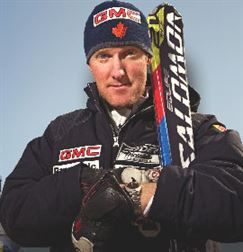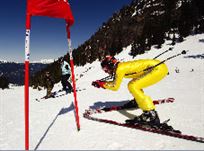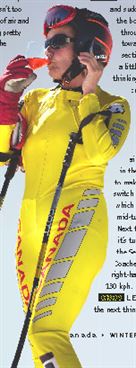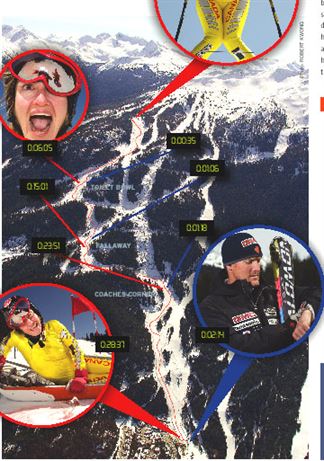Women’s head coach Rob Boyd helped Leslie Woit cut her time in half on Whistler’s Dave Murray Downhill
It’s three kilometres of ultra-steep, stomach-churning drops and ligament-snapping compressions—a racecourse that helps provide the most exciting two minutes of the Winter Olympics. With all the crash-addled eyes of the world about to fix on every nasty nuance of the Dave Murray Downhill, we turn to one of Canada’s most beloved ski racers for professional advice. Rob Boyd took the gold on this very course in 1989—the first Canadian to win a World Cup downhill on home turf—and knows every nook and cranny.
 “I used to ski that run home every day during Christmas breaks, spring skiing…whenever I could,” Rob recalls. “I would hike up it in the summer and mountain bike down it. One summer I worked for Whistler Mountain on the trail crew and I hoofed bags of cement mix up to Coaches Corner for the A net system—two at a time.”
“I used to ski that run home every day during Christmas breaks, spring skiing…whenever I could,” Rob recalls. “I would hike up it in the summer and mountain bike down it. One summer I worked for Whistler Mountain on the trail crew and I hoofed bags of cement mix up to Coaches Corner for the A net system—two at a time.”
Now the father of two boys under five, Dylan and Evan, Rob is sharing his expertise with the next generation of Canucks: his “other job” is coach of the women’s Canadian Alpine Ski Team.
“Every course has its unique characteristics,” explains Boyd. “Some have tough sections separated by easy sections, some are tough all the way down. The Dave Murray Downhill builds up to tough, but fun sections in the middle, and now with the new lower section, keep that fun challenge all the way to the finish. You have to be sharp and on top of things right to the finish line.”
Of course, we need more than good advice to ski a downhill course like a pro. Try talent, strength, training and balls—but still, any recreational skier can ski the Dave Murray Downhill and get that sort-of-like-a-pro sensation. To find that feeling, the brain trust at Ski Canada HQ took one gold-medal coach, packed a random woman (me) into an authentic Crazy Canuck catsuit, grabbed a map and some extra provisions, and prepared to giv’er. Ooh, and we also tried to hold our tummy in at the same time (okay, that was me, not Rob). No one said it would be easy….
0:00:00 LESLIE: So this is what it’s like standing poised behind the start wand the moment those beep-beep-beepers sound.
0:00:00 ROB: How you feel in the start gate depends on how well you’ve prepared leading up to race day, how well you know the course, and whether or not you really want to keep your head down and attack every section. If you can rate 10 out of 10 for those questions, then you’re champing at the bit and ready to charge down the hill for the most exhilarating two minutes of ski racing.
 0:02:46 LESLIE: Okay, my massage at the Chateau Whistler already seems less than adequate preparation. Why oh why didn’t I go for the deep tissue!
0:02:46 LESLIE: Okay, my massage at the Chateau Whistler already seems less than adequate preparation. Why oh why didn’t I go for the deep tissue!
0:00:26 ROB:I’m about to enter the Toilet Bowl, hungry for speed and trying to keep as low as possible. From the Start, it isn’t too challenging—lots of tucking, a bit of air and long gliding turns. But you’re going pretty fast—130 kph—when you get to the 30-metre jump entering the Toilet Bowl. (They tried to change the names, kinda like all those other things in life that seem to be too offensive to certain types, but we all use the originals.)
0:014:48 LESLIE: 30-metre jumps? At 130 kph? Who needs a toilet bowl, I’m already scared $#!+less!
0:00:32 ROB:Skiers pick up more speed as they accelerate down toward Carousel turn and the Weasel. A tough turn on the flats that you want to take as much speed through as possible to where the bottom drops out. You gotta get forward and giv’er down a steep and bumpy pitch—this is where things get really hairy.
0:18:00 LESLIE: No problem, I just came from my waxing appointment at the spa.
0:00:58 ROB: One more turn and suddenly you’re at the bottom and turning through a compression toward the Fallaway section. I’m breathing a little harder and thinking I’m going to cut off the line a bit more because I know I can take some risks and I’m feeling strong. A bit of air time, switching in the air and ready to make another quick switch to the Fallaway, which does just that mid-turn—falls away. Next thing you know, it’s turbo-time down the Sewer toward Coaches Corner, a tough right-hand turn at about 130 kph.
 0:18:09 LESLIE: And the next thing you know it’s actually cocktail hour! I prefer to slow down and carefully consider that right-hand turn by taking a directional reading—straight through the accurate prism of a martini glass.
0:18:09 LESLIE: And the next thing you know it’s actually cocktail hour! I prefer to slow down and carefully consider that right-hand turn by taking a directional reading—straight through the accurate prism of a martini glass.
0:01:18 ROB:I just pulled off an amazing turn through Coaches Corner. After a little mistake from Fallaway (anyone remember me flying sideways through the air there?), I knew I had to make up time so I tucked farther into Coaches Corner than anyone had before and just pulled it off—with a lot of speed. This is where I won the race back in ’89, from Coaches Corner down. I tucked more than ever, low, hands up high and absorbing every little ripple. The course was longer then, going right down to Dusty’s, so stamina was key to the bottom.
0:23:51 LESLIE:Okay, I’m here at Coaches Corner—I wonder how I got ahead of him? Maybe I’ll just eat this half of a Sweet Marie I found in Chris’s cat suit.
0:01:48 ROB:Then comes the new section, the Powerline Traverse to a few rolly turns that lead to a big double jump (40 metres plus), followed by another 40-metre crowd-pleaser jump, which sends the racers on a long flight toward the finish line.
0:28:37 LESLIE: Ooh, legs a bit wobbly so lying down seems the order of the day. I normally only take my “long flights” in business class. So, Rob, at what point did you know you had nailed it in 1989?
0:02:14 ROB: First training run. I won the two training runs I took (there was another training run, but I opted not to take it because I didn’t want to over-analyze or second-guess my chosen line). Then on race day I just tried to repeat that same feeling. I had prepared well and although the legs were a little tired, I had paced it just right and had juice in them to make the most out of the bottom sections.

Special thanks to: Colourist and wardrobe expert Chris Kent, planetary co-ordinator Lauralee Bowie, family planning Krista Watts and Benjamin Cooper, Intrawest liaison Christina Moore and Vanessa Murphy, and Whistler Ski Patrol for putting up with Leslie’s antics in general.
FACTS + STATS
- Downhillers regularly exceed speeds of 130 kph. In some sections, racers on the Lauberhorn in Wengen, Switzerland, and the Hahnenkamm in Kitzbühel, Austria, have hit 150 kph (93 mph).
- Only two Canadian men have won medals in Olympic alpine events,both downhill bronze medals: Steve Podborski at the 1980 Lake Placid Games, and Edi Podivinsky at the 1994 Lillehammer Games.
- Canada’s women on the other hand, have clocked up eight Olympic alpine ski medals:Lucile Wheeler ,downhill bronze at the 1956 Cortina Games; Anne Heggtveit ,SL gold,1960 Squaw Valley; Nancy Greene, GS gold and SL silver, 1968 Grenoble;Kathy Kreiner ,GS gold,1976 Innsbruck; Karen Percy, downhill and SG bronze,1988 Calgary;and Kerrin Lee-Gartner, downhill gold,1992 Albertville.



